

The morning sunlight streamed through the ward window onto the electric nursing bed. Grandpa Li, 68 years old, gently pressed the remote control, and the bed board slowly rose to a 45-degree Angle. He picked up "Ordinary World" on the desk. This was the first time in three months that he could independently read a paper book. Once, his spinal injury made him have to rely on others to even look up, but now, this hospital bed that can "understand" instructions is quietly reshaping the course of his life. In traditional perception, hospital beds are cold medical symbols. However, for disabled patients who have been bedridden for a long time, the significance of a multi-functional nursing bed far exceeds that of a "rest tool". The care system centered on the electric nursing bed transforms "passive bed rest" into "active living" through precise adjustments such as the lifting of the backboard, the bending of the legs, and the overall tilting. Patients can adjust to a semi-recumbent position for eating independently to avoid the risk of choking cough. The leg care module supports the blood circulation of the lower extremities and prevents deep vein thrombosis. The intelligent pressure dispersion system of the patient bed for preventing pressure sores has reduced the incidence of pressure sores by more than 70% through fine-tuning every 20 minutes. These seemingly simple mechanical movements are actually "invisible crutches" for the disabled to fight against physical limitations. More profound changes occur at the psychological level. The director of the rehabilitation department of a tertiary hospital observed: "In the past, patients often fell into depression due to their inability to take care of themselves in daily life. Now, they can control the bed by themselves to complete washing, reading and even video calls. The light in their eyes is obviously different." The "barrier-free design" of the electric nursing bed gives patients decision-making power: when they need care and when they long for solitude can all be controlled through the remote control. This sense of control over the pace of life is like opening a breathable window in a confined space. Technology empowers not only patients but also caregivers who are shouldering the burden. Ms. Wang, a family member, expressed her feelings, saying, "In the past, it took two people to turn my father over. Now, I can operate the bed up and down with one hand, and the energy saved enables me to talk to him more." The intelligence of electric medical nursing beds is reshaping the care relationship - shifting from "physical exertion" to "emotional support", allowing family affection to return to its essence of companionship. When medical devices began to focus on "human dignity", the cold metal also gained warmth. From hospitals to homes, from functional satisfaction to psychological reconstruction, the iteration of electric nursing beds reflects the cognitive leap of society towards the disabled: what t...
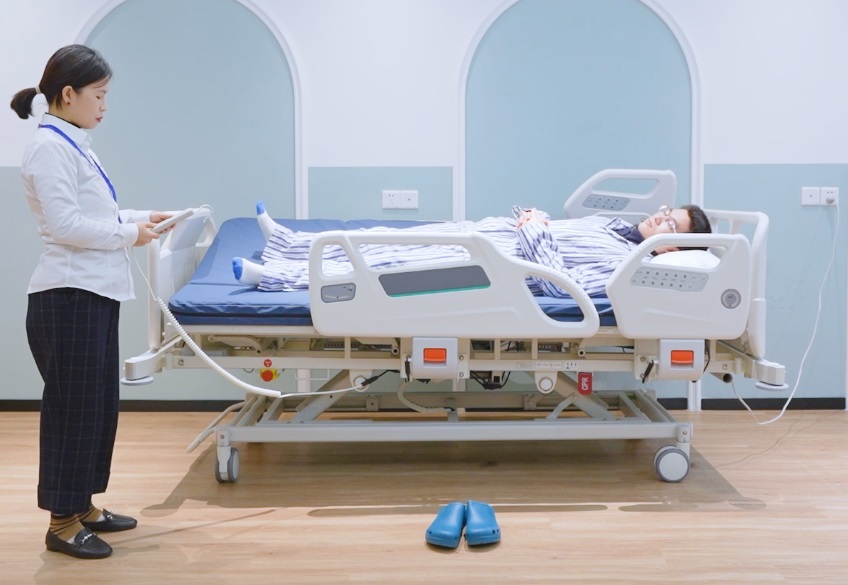
In the newly launched smart ward of a certain tertiary hospital, an intelligent hospital bed integrating Internet of Things and artificial intelligence technologies is quietly reshaping the daily routine of nursing work: nurses only need to tap the remote control, and the bed can be smoothly raised and lowered to the designated Angle. When the patient turns over, the mattress pressure sensor automatically records the vital sign data. Even the most physically demanding task of material handling is shouldering 80% of the load by hidden electric power-assisted devices. How does this multi-functional nursing bed, which is called a "stress-reducing wonder" by medical staff, make the nursing work "smooth"? mut The "heaviness" of hospital beds in traditional hospitals used to be a collective pain point for the nursing community. Manually adjust the Angle of the bed board, repeatedly move the heavy infusion stand, and manually weigh and record at regular intervals... These repetitive labors not only consume physical strength, but also occupy the golden time that should be used for observing the condition and communicating with patients. The popularization of electric nursing beds has completely broken through this predicament. Take a certain brand of smart hospital bed as an example. Its integrated design deeply integrates the infusion stand, position adjustment and weighing system. Nurses can complete more than 20 operations through the touch screen. While saving physical strength every day, the operation error rate is reduced to less than 0.3%. What is even more commendable is the "invisible service" capability of the smart hospital patient bed. The built-in AI algorithm can analyze the patient's body movement data in real time and give early warnings of the risk of falling out of bed. When the infusion is coming to an end, the intelligent system will automatically reduce the flow rate and send a reminder to the nurse station to avoid the risk of blood backflow. In the pilot department of cardiovascular internal medicine, this system has reduced the frequency of nurses' night rounds by 60%, but has increased the response speed to emergencies by three times. Ms. Li, the head nurse, said with emotion, "In the past, we were like clocks wound up tightly. Now, we finally have time to hold patients' hands and chat about daily life." Technological innovation brings not only a leap in efficiency, but also a profound transformation of the nursing model. The new generation of intelligent hospital beds has achieved seamless integration with the hospital HIS system, and the full-process data of patients from admission to discharge is automatically synchronized to the electronic medical record. This means that nurses no longer need to manually transcribe vital sign records and can devote more energy to core medical tasks such as pain management and psychological counseling. In the pediatric ward, the smart nursing beds equipped with cartoon interfaces can even soot...

As society enters a deep aging stage, home-based elderly care has become the choice of most families. An electric nursing bed that can be "raised and lowered with one click" and "automatically turned over" is quietly changing the later years of millions of elderly people. From medical institutions to living rooms and bedrooms, this seemingly ordinary home upgrade is actually a microcosm of the deep integration of technology and humanistic care. Function Iteration: From "For medical use Only" to "Standard for Families" Traditional nursing beds have long been confined to hospital Settings due to their bulkiness and complex operation. The new generation of electric nursing beds, through modular design, condenses technologies such as hydraulic lifting, intelligent remote control, and body position adjustment into home scenarios. For instance, both the manual and electric nursing beds of Xiamen Weiyou Intelligent Technology Co., Ltd. support stepless adjustment from 0 to 75 degrees, allowing the elderly to independently perform actions such as raising their backs and legs. Anti-skid and anti-slip safety guardrails and emergency call systems make remote supervision of children possible. Data shows that in the first quarter of 2025, the sales of home care beds in China increased by 42% year-on-year, among which the demand for "elderly-friendly renovations" accounted for more than 60%. Scene Revolution: One Bed Supports the "Home-based Elderly Care Ecosystem" In the home of Aunt Li, a retired teacher in Hangzhou, the electric nursing bed is not only a sleeping tool but also a health management center. By connecting to the smart bracelet, the bed body can monitor the heart rate and breathing rate in real time. When the data is abnormal, it will be automatically pushed to the children's mobile phones. Equipped with detachable dining boards and toilet assistance devices, the elderly can complete their daily activities without getting out of bed. This "multi-functional elderly nursing bed" design concept is driving home care to shift from "passive care" to "active health management". Market penetration: Affordable prices have driven a consumption boom Not long ago, electric nursing beds were beyond the reach of ordinary families due to their prices often amounting to tens of thousands of yuan. Nowadays, with the maturation of the supply chain for electric nursing beds, products priced between 3,000 and 8,000 yuan have occupied the mainstream market. Data from a certain e-commerce platform shows that during the "Double 11" period in 2025, the transaction volume of home care beds priced at over 1,000 yuan exceeded 100,000 units, with over 80% of the buyers being ordinary working-class families. The "people-friendly" pricing has made technological elderly care no longer a privilege for a few. Policy tailwind: Elderly-friendly renovations unleash essential demand The promotion at the government level has pressed the accelerator for the popularization of electric...
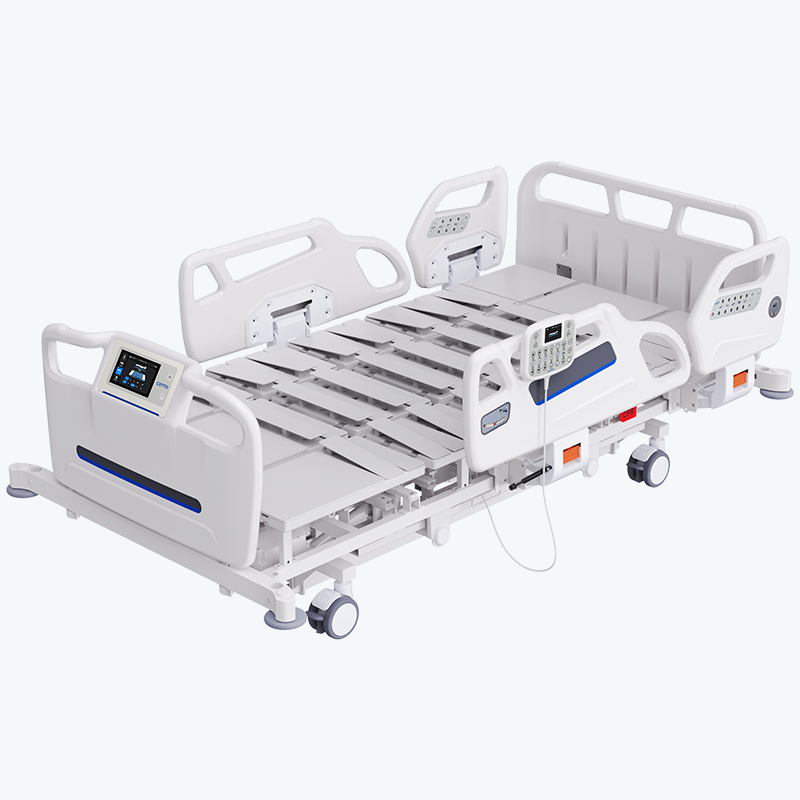
In the field of medical care, the prevention of bedsores has always been a core challenge in the care of patients who have been bedridden for a long time. Data shows that the global annual treatment cost for complications caused by bedsores amounts to hundreds of billions of dollars, and the functional limitations of traditional nursing beds often leave patients in a predicament of "passive care". Nowadays, an intelligent anti-bedsore electric patient care bed from Xiamen Weiyou Intelligent Technology Co., Ltd. is rewriting this situation with a breakthrough design - it deeply integrates bionic mechanics and ergonomics, pushing the prevention of bedsores from a "passive response" to a new era of "active intervention". As an innovator in the field of bedsores prevention medical beds, the Weiyou electric nursing bed has pioneered a three-fold left and right turning system, subverting the traditional one-plane design logic of nursing bed sheets. Its built-in intelligent chip can precisely simulate the natural turning rhythm of the human body. It automatically initiates a 15° left and right turning action every two hours. Combined with adjustable turning speed and Angle, it effectively disperses the pressure on the bony process area. What is more worthy of attention is that the bed board adopts a unique "piano key" structure design, and through mechanical transmission, the grating plates alternately rise and fall in units of 3 centimeters. This dynamic bed surface forms micro-airflow channels when the patient lies down, enabling more than 60 pressure switches per square centimeter per hour on the body contact surface, promoting microcirculation in capillaries and blocking the formation path of bedsores from the root. Clinical verification data shows that the incidence of bedsores among patients using the Weiyou electric nursing bed is 83% lower than that of traditional nursing equipment. This achievement is attributed to its dual innovative mechanisms: the dynamic pressure dispersion technology shorts the skin pressure time by 75%, while the air convection design maintains the bed surface humidity within the golden range of 45% to 55%. For critically ill patients in the ICU, the specially designed cardiac chair position function of this device can achieve stepless adjustment from 0 to 80 degrees. Through precise support, it maintains the stability of the patient's cardiopulmonary function and builds a "second line of defense" for the life support of critically ill patients. In emergency rescue scenarios, the one-click CPR function of the Weiyou electric nursing bed demonstrates an astonishing efficiency advantage. In an emergency, the nursing staff only need to touch the button, and the bed board can be flattened and deformed within 3 seconds, creating a golden rescue space for cardiopulmonary resuscitation operations. This design concept that deeply integrates daily care with emergency needs has enabled the equipment to break through the positioning...
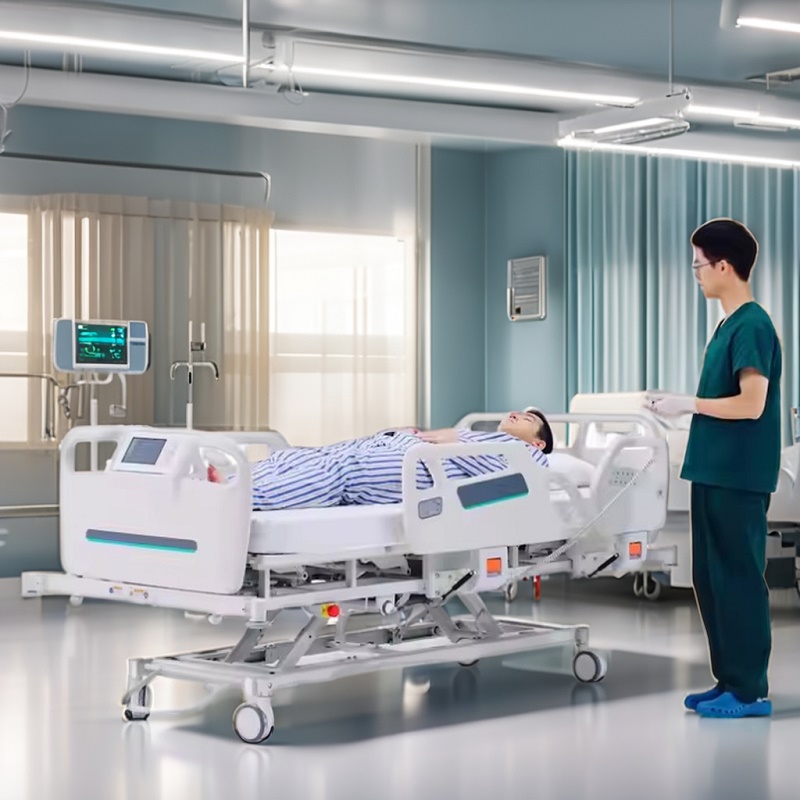
At three o 'clock in the morning in the hospital corridor, the alarm of the monitor pierced the silence. When the nurse rushed into the ward to perform cardiopulmonary resuscitation on a patient with cardiac arrest, the "wisdom" of a bed was quietly accelerating this life-and-death game - with just a light touch of the button, the bed instantly switched to CPR mode, the back automatically flattened and the legs lowered simultaneously, buying the precious golden four minutes for the rescue. This is not a scene from a science fiction movie, but a microcosm of how electric nursing beds are reshaping modern medical care. As an "invisible revolutionary" in the field of medical equipment, electric medical nursing beds are breaking the efficiency deadlock of traditional wards with the power of technology. Traditional manual adjustment of the height and Angle of the bed often requires nurses to bend over repeatedly. In the intensive care unit (ICU), such actions are repeated on average hundreds of times a day, which not only consumes the energy of medical staff but may also delay emergency treatment. Nowadays, smart ICU nursing beds integrating functions such as electric lifting, one-button CPR, and automatic weighing have reduced the nursing response time by more than 30%. Data from a certain tertiary hospital shows that after the introduction of multi-functional electric nursing beds, the turnover rate of ICU wards increased by 18%, and the average length of hospital stay for patients was shortened by 1.2 days. This "revolution on the bed" goes far beyond the upgrade of basic functions. In response to the needs of different departments, medical care beds are evolving into specialized solutions: In the neurology department, electric beds equipped with anti-bedsores air cushions and position memory functions can automatically adjust the bed Angle to prevent complications; In obstetrics, the nursing bed with a delivery assistance mode can flexibly adapt to changes in the labor process. In the geriatrics department, smart beds equipped with voice interaction and remote monitoring systems enable disabled patients to convey their needs without having to ring a bell. Behind these innovative designs lies the deep integration of medical scenarios and industrial design. What is more worthy of attention is that electric hospital beds are reshaping the model of medical and nursing collaboration. In the past, adjusting the position of critically ill patients required the collaborative operation of 2 to 3 people. Nowadays, a single person can switch over 20 different positions through remote control. A pilot program in a certain hospital found that nurses' average daily physical exertion decreased by 40%, enabling them to devote more energy to observing patients' conditions and communicating with them. In public health emergencies, the modularly designed ICU nursing beds can also be quickly transformed into isolation cabins. Their negative pressure system and intell...
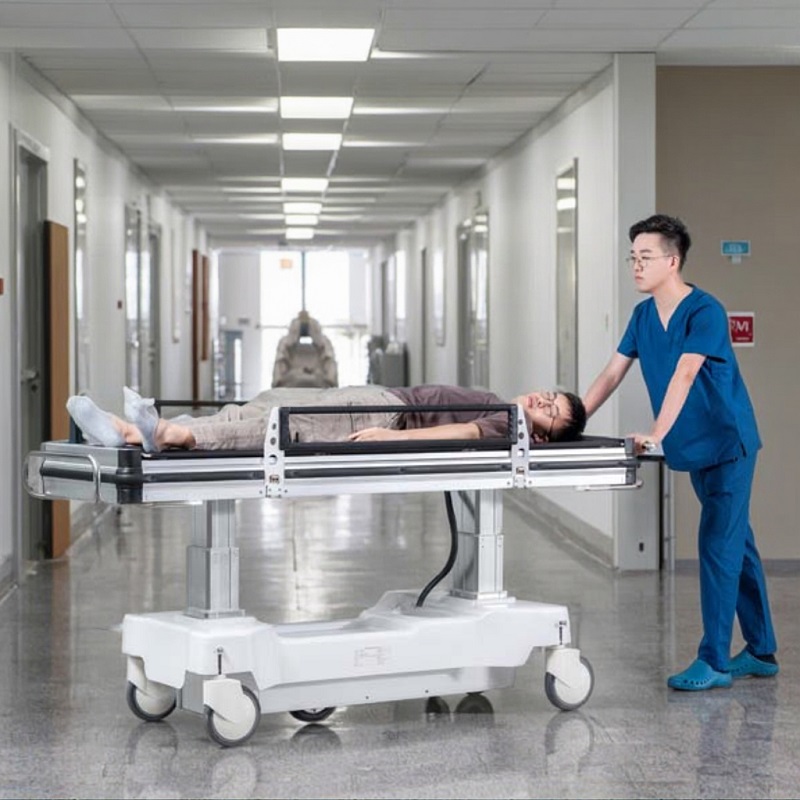
At three o 'clock in the morning in the hospital emergency room, the shrill alarm broke the silence. Nurse Li Ting pushed the transfer bed carrying patients with myocardial infarction and raced against time in the crowded corridors - this is a microcosm that the 3 million medical workers in China face every day. The traditional manual transfer bed not only requires the collaboration of multiple people to move stably, but also causes 68% of the nursing staff to suffer from lumbar muscle strain due to frequent bending and pushing and pulling operations. Nowadays, a technological storm triggered by automatic patients transfer unit is redefining the underlying logic of medical care. At Sir Run Run Shaw Hospital Affiliated to the School of Medicine of Zhejiang University, an electric transfer bed equipped with a laser navigation system is autonomously shuttling between the CT room and the operating room at a speed of 0.5 meters per second. This device achieves millimeter-level positioning through AGV automatic guidance technology. Combined with the Internet of Things control module, it can synchronize the patient's vital signs data to the medical system in real time. Even more revolutionary is its "zero-contact" transfer design: when critically ill patients need to undergo multi-departmental examinations, medical staff only need to input the destination on the tablet terminal, and the device can automatically plan the optimal path to avoid crowds and obstacles, increasing the transfer efficiency in the emergency scene by 40%. Technological breakthroughs bring about not only an efficiency revolution. In traditional transfer, cases where patients' conditions worsen due to jolts are not uncommon. However, the new emergency electric hospital bed for patient transfer adopts a six-dimensional shock absorption system and a pneumatic suspension device, which can control the vertical vibration amplitude within 2 centimeters even when turning at high speed. In the actual test at Union Hospital in Wuhan, this device reduced the risk of secondary injury for patients with brain trauma during the transfer process by 72%. Even more astonishing is its modular design: the bed can be instantly switched to the operating table mode, securing the "golden 4 minutes" for rescue. The profound value of this transformation lies in the reconfiguration of medical resources. After Peking Union Medical College Hospital introduced the intelligent transfer system, a single device can replace two full-time transfer personnel. While reducing labor costs by 60%, it enables nursing staff to return to core diagnosis and treatment work. In the European market where labor costs are high, data from a hospital in Germany shows that automated transfer equipment has reduced the physical labor intensity of night shift nurses from 12 times per hour to 2 times, and the rate of job burnout has dropped sharply by 53%. When technology breaks through the critical point, industry standards are natural...
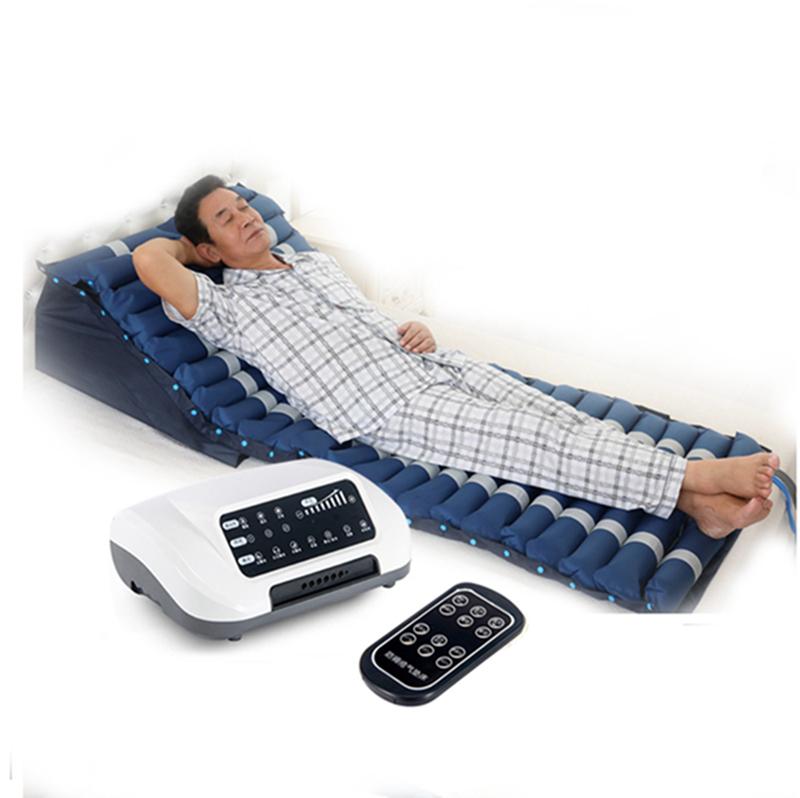
When 82-year-old Grandma Liu was bedridden due to hip replacement surgery, what her family was most worried about was not the surgery itself, but the unavoidable shadow in postoperative care - bedsores. But in a rehabilitation hospital in Shanghai, a device called "Anti-Bedsore alternating pressure air mattress" has changed all this: The surface of the air cushion seems calm, but in fact, it completes a "pressure transfer" every 10 minutes, just like countless pairs of invisible hands weaving a protective net under the skin. At the end of the three-month care cycle, Grandma Liu's skin was as good as new, and this is precisely a microcosm of the global medical technology revolution. This technology, known as "dynamic pressure dispersion", is essentially a precise art of air flow arrangement. The static support of traditional care pads is like keeping the skin "fixed" for a long time, while the anti-bedsores air mattress uses an internal air pump to drive multiple independent air chambers, simulating the pressure changes during human activities with millimeter-level precision. Take the anti-bedsores inflatable mattress with pump of Xiamen Weiyou Intelligent Technology Co., Ltd. as an example. Its 20 cross-arranged air chambers can form a "wave-like" pressure gradient. When the left air chamber is inflated, the right side synchronously depressurizes, ensuring that any part of the body is under pressure for no more than 2 hours - this is precisely the internationally recognized threshold for preventing bedsores. Clinical data show that this technology can reduce the incidence of bedsores by 72% and lower the risk of infection caused by skin damage in patients by 58%. The explosive growth of the market confirms the urgency of demand. In 2023, the global market size of air mattresses for preventing bedsores reached 5.8 billion US dollars, with the proportion of household scenarios exceeding 40% for the first time. Behind this transformation lies a thorough innovation in product design: from bulky equipment exclusive to medical institutions to the "home use air mattress" weighing less than 8 kilograms, consumers can bring professional care into their living rooms for just $300- $800. In a certain elderly care community in Chengdu, 75-year-old Grandpa Zhou is experiencing the dignity brought by technology. The "patient nursing mattress" he uses is equipped with a built-in temperature and humidity sensor. When it detects that the micro-environment on the back is damp, it will automatically activate the ventilation mode. Combined with a pressure rotation every two hours, it completely says goodbye to the stuffiness and stickiness of traditional nursing mattresses. The data presented by the caregivers is astonishing: the incidence of bedsores among the elderly residents has dropped from the industry average of 25% to 3.7%, and the frequency of changing care pads has decreased by 60%. The limitations of traditional care pads become increasingly prominent in ...

In the community rehabilitation center in the early morning, 65-year-old Aunt Zhang was skillfully using air compression leg massage boots for leg treatment. As the air pressure massage machine started quietly, the compression boots regularly inflated and contracted from bottom to top. "Before, I had to go to the hospital three times a week for barometry. Now, I can take care of varicose veins at home, which is much more convenient." " The "magic tool" she mentioned is precisely the home air compression leg massager that has become popular in recent years. Can this type of equipment truly replace medical physiotherapy? How should its technical principles and applicable boundaries be understood? Air compression therapy: A "Blood Circulation Revolution" from Hospitals to Homes Air compression technology simulates muscle contractions and applies pressure to the legs through periodic inflation and deflation, promoting venous blood return and alleviating edema. The medical field has long used it for the prevention of deep vein thrombosis (DVT) and postoperative rehabilitation. For example, the air compression massage machine in hospitals usually adopts a gradient pressure design, with the pressure decreasing step by step from the ankle to the thigh, precisely simulating the muscle pump effect when the human body walks. The home-use version of air compression leg massage boots simplifies the operation and achieves daily care through preset modes. It is particularly favored by people with varicose veins, those who stand for long periods, and those recovering after surgery. Home vs. Medical: The "Watershed" between Pressure and Scenarios Although the principles are similar, there are key differences between household and medical devices. Medical-grade equipment has a wider pressure range (up to 80-120 MMHG), and the treatment plan needs to be customized by the doctor based on the patient's condition. It is often used for postoperative rehabilitation or the treatment of severe venous insufficiency. The pressure of a household air compression leg massager is usually controlled at 40-60mmHg and is mainly used for daily health care, such as relieving leg soreness and swelling caused by prolonged sitting. In addition, medical equipment mostly adopts multi-chamber independent inflation, and the pressure control is more precise. The household models are mainly single-chamber or double-chamber, which have lower costs but weaker adaptability. Applicable population and Risk Warning: Not a "panacea" Experts caution that although leg compression boots are convenient, they are not suitable for everyone. Early-stage patients with varicose veins can improve their symptoms by using it for 15 to 20 minutes daily, but it should be contraindicated for those with severe ulcers, arteriosclerosis or skin infections. More importantly, household appliances cannot replace professional diagnosis. There have been patients who purchased items on their own but neglected regular chec...
Categories
New Products
Pneumatic Compression Massage Lymphatic Drainage Machine at Home Read More
Sport Recovery Cold and Hot Circulation Therapy System Read More
China Pneumatic Compression Massage Device for Full Body Lymphatic drainage Read More
Factory Price Cold and Hot Circulation Compression Therapy Machine Read More
Professional Lymphedema Massage Machine for Arm and Upper Body Read More
High Quality Hospital Transfer Equipment Automatic Patient transfer Bed Read More
New Trending Four Channels Tens Unit Therapy Device Read More
Multi-Functional Anti-Bedsore Electric ICU Bed in Hospital Read More
New Design Multi-functional Electric Clinic Patient Bed Read More
Customized 12 Chamber Leg Compression Pump for Lymphedema Treatment Read More
High Quality Wood Home Nursing Bed for Bedsore Prevention Read More
Copyright © 2025 Xiamen Weiyou Intelligent Technology Co.,Ltd. All Rights Reserved. Power by

IPv6 network supported